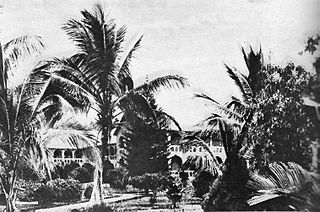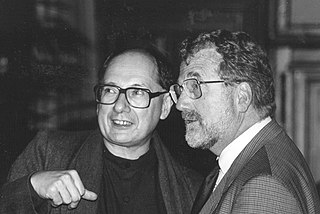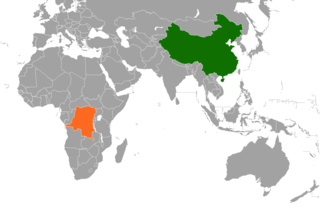
Anderlecht is one of the 19 municipalities of the Brussels-Capital Region, Belgium. Located in the south-western part of the region, it is bordered by the City of Brussels, Forest, Molenbeek-Saint-Jean, and Saint-Gilles, as well as the Flemish municipalities of Dilbeek and Sint-Pieters-Leeuw. In common with all of Brussels' municipalities, it is legally bilingual (French–Dutch).

Joseph Kasa-Vubu, alternatively Joseph Kasavubu, was a Congolese politician who served as the first President of the Democratic Republic of the Congo from 1960 until 1965.

Kisangani is the capital of Tshopo province in the Democratic Republic of the Congo. It is the fifth most populous urban area in the country, with an estimated population of 1,312,000 in 2021, and the largest of the cities that lie in the tropical woodlands of the Congo.

Kisantu, is a town in the western Democratic Republic of Congo, lying south west of Kinshasa, on the Inkisi River. It is known for its large cathedral and for its botanical gardens, which include an arboretum of indigenous trees.

The University of Kinshasa, commonly known as UNIKIN, is one of the three major universities in the Democratic Republic of the Congo, together with the University of Kisangani and University of Lubumbashi. Originally founded in 1954 as Lovanium University during Belgian colonial rule, the current university was established following the division of the National University of Zaire (UNAZA) in 1981. The university is located in Kinshasa's Lemba commune.

Marc, Baron Van Montagu is a Belgian molecular biologist. He was full professor and director of the Laboratory of Genetics at the faculty of Sciences at Ghent University (Belgium) and scientific director of the genetics department of the Flanders Interuniversity Institute for Biotechnology (VIB). Together with Jozef Schell he founded the biotech company Plant Genetic Systems Inc. (Belgium) in 1982, of which he was scientific director and member of the board of directors. Van Montagu was also involved in founding the biotech company CropDesign, of which he was a board member from 1998 to 2004. He is president of the Public Research and Regulation Initiative (PRRI).
Paul Splingaerd was the Belgian foundling who became an official or mandarin (bureaucrat) in the late Qing government. As both a Belgian and a Chinese mandarin, Paul acted as a liaison on various Sino-Belgian projects in the late nineteenth century. The best known are the negotiations for Belgium to build the first major railway in China, the Beijing-Hankou Railroad and the development of a Belgian-Chinese industrial, mining and commercial enterprises in Lanzhou, the capital of Gansu province. Although better known in China where he was known by many names, including Lin Fuchen, Su Pe Lin Ge Er de (斯普林格尔德), Lin Balu Lin Bao luo, Bi lishi Lin, Lin Darin, Lin Ta Jen, in European circles he developed the reputation for being the "Famous Belgian Mandarin." Paul also initiated negotiations for the First Iron Bridge Across the Yellow River in Lanzhou, China, now known as Zhongshan Bridge, but died before it was built.

The People's Republic of China (PRC) and the Democratic Republic of the Congo (DRC) have maintained diplomatic relations since 1961 and contacts between the two regions stretch back to 1887 when representatives of the Congo Free State established contacts with the court of the Qing dynasty. The first treaty between the two powers was signed in 1898.
Yangambi is a town in Isangi territory of Tshopo province, Democratic Republic of the Congo.
Marcel Florent De Boodt was a professor emeritus of the University of Ghent and has been dean of the Faculty of Agriculture and the Belgian national delegate to the UNESCO Man and the Biosphere Programme.
The African Wildlife Defence Force (AWDF), Kikosi cha ulinzi ya wanyama pori barani Afrika (Swahili), is a private park ranger and anti-poaching organization based in Dungu, in the north-east of the Democratic Republic of the Congo. AWDF uses direct action tactics to protect wildlife and rainforests. The organization was founded in 2012 by Congolese-Belgian philanthropist Jean Kiala-Inkisi. It is proposed as an alternative to regular park ranger organizations who struggle with corruption, and seeks to eliminate the increasing levels of violence which poachers face.

Bert Marc Weckhuysen FRSC is a professor of inorganic chemistry and catalysis at Utrecht University, originally from Belgian descent. Weckhuysen is best known for his developments in operando (micro)spectroscopy; imaging catalysis at macro, meso and micro scales, from the reactor down to interactions between single atoms and molecules. He was a winner of the 2013 Spinoza Prize, and was knighted in the Order of the Netherlands Lion in 2015.

Frans Hemerijckx (1902–1969) was a Flemish leprologist, humanist and the founder of the Damien Foundation in Belgium, a non profit non governmental organization engaged in providing treatment and rehabilitation services to people afflicted with leprosy. He spent most of his life in the treatment and rehabilitation of leprosy patients and initiated a mobile leprosy treatment methodology, Clinic under the trees. On 13 September 1975, Government of Belgium honoured Hemerijckx by issuing a commemorative stamp, depicting his image. (9615) Hemerijckx, a Main-belt comet discovered in 1993 by Eric Walter Elst is named after the Flemish doctor.
The following is a timeline of the history of the city of Kisangani, Democratic Republic of the Congo.

Ève Bazaiba Masudi is a Congolese lawyer, politician, and human rights activist. As of May 2019, she served as the Secretary General of the Movement for the Liberation of the Congo (MLC) political party. She is Deputy Prime Minister and Minister for the Environment since 2021.
The following lists events that happened during 1905 in the Kingdom of Belgium.

The Tshopo River is a river in the Democratic Republic of the Congo. It flows through the north of the city of Kisangani and joins the Lindi River just before that river enters the Congo River. It gives its name to the province of Tshopo.

Frans Carl De Schryver is a Belgian chemist currently serving as Professor Emeritus in the Department of Chemistry of the KU Leuven. Pursuing his interests in polymer synthesis, time and space resolved chemistry, he founded the Laboratory for Photochemistry and Spectroscopy at the KU Leuven. He has co-authored over 650 papers in peer-reviewed journals.
The Zongo II Power Station, also Zongo 2 Power Station, is a hydroelectric power station across the Inkisi River that harnesses the energy of the Zongo Falls in the Democratic Republic of the Congo. Construction began on 14 March 2012 and concluded in 2018. The power station was officially inaugurated on 22 June 2018 by the President of the DR Congo, at that time, Joseph Kabila.
Alphonse Frédéric De Moerloose, born in Gentbrugge, Belgium, on 12 January 1858, died in Schilde, Belgium, on 27 March 1932 was a priest of the Congregation of the Immaculate Heart of Mary [CICM] and a Belgian architect. He was a missionary in China from 1885 to 1929 and built several Catholic churches in Inner Mongolia and North China.











